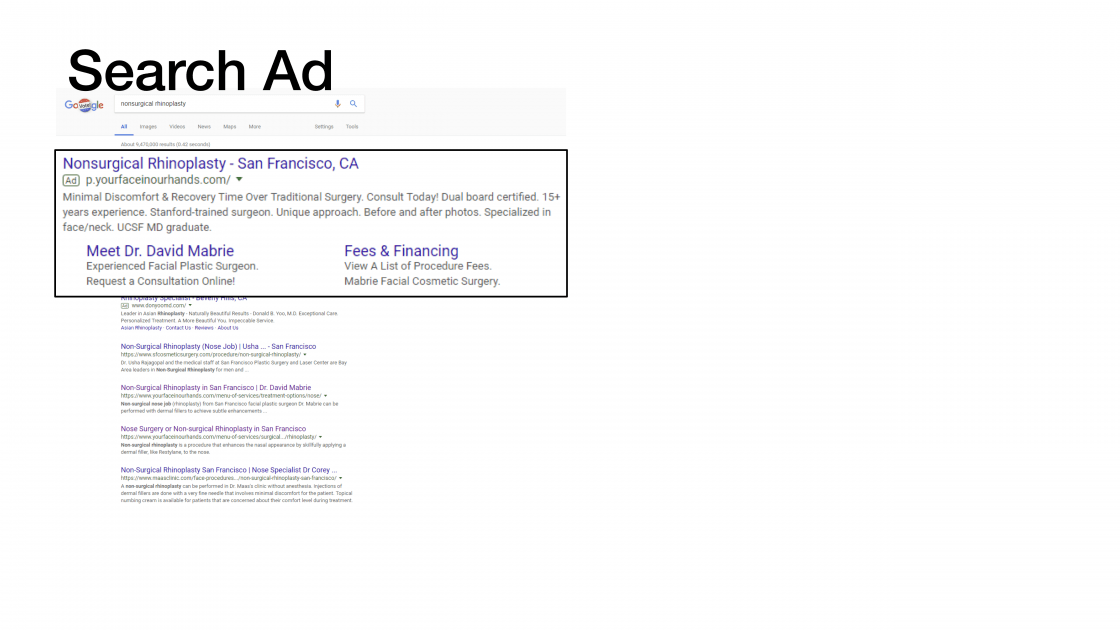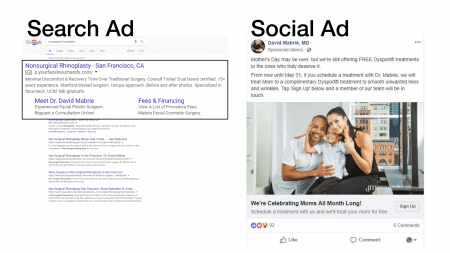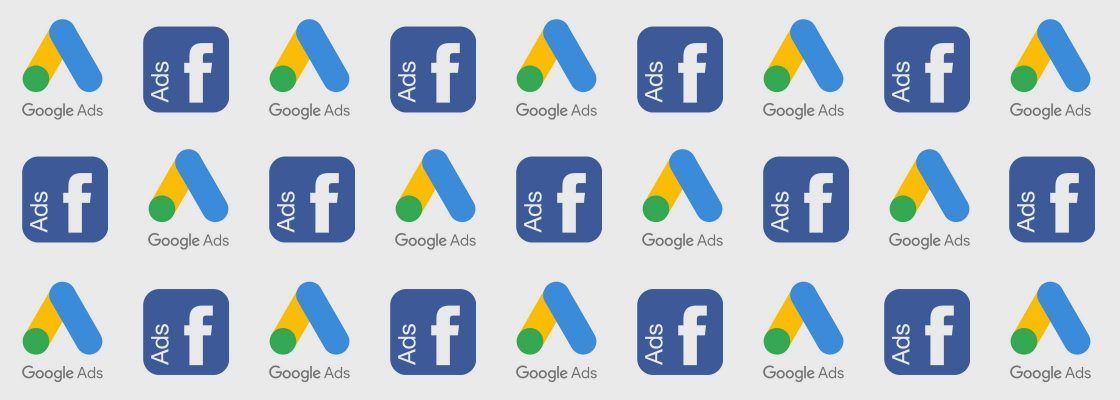“Should I be using Google Ads or Facebook Ads?”
This is one of the most frequent questions we receive at Etna Interactive. And while each platform is great for reaching your customers online, the answer is always the same: It depends.
In this month’s blog post, CEO Ryan Miller discusses the difference between the two, as well as why the path to your practice’s answer starts with your business goals.
Video Transcription
Hi again and happy holidays! It’s Ryan with Etna Interactive. Now it’s wintertime, so, of course, I have the obligatory cold. I’m over it now, just a little bit of laryngitis. There was originally a 50/50 chance that I’d lose my voice midway through the recording, but don’t worry — my team has assured me that if my voice goes out to keep moving my lips and they are going to dub me over like an old Samurai movie. Hopefully that won’t happen.
We’re here today to talk about search vs. social advertising. It’s a topic we get asked about all the time. You’ve seeing the context of which one is right, given the goals of a particular practice. Now, if you’re not familiar with them, Google Ads (they recently renamed it from Google Ad Words) are those little ads that run just above or just below the organic search results when you search on the desktop. They look like this:
 Now, social ads on the other hand, are ads that are sort of interspersed inside of your social news feed, and they look a little bit more like this:
Now, social ads on the other hand, are ads that are sort of interspersed inside of your social news feed, and they look a little bit more like this:

They look a little bit more like post content.
Now, when we look at the two different platforms, you have to wonder, “Which one is going to serve the goals of our business?” Both of these platforms, we have to understand what’s really attractive about them, is that the results are instantaneous. We can decide to run them now and, by this afternoon, we can be in a position where we’re starting to see traffic or response from those ads right away. They also offer detailed tracking that will help us assess whether or not we’re getting the value that we expect for the investment that we’re making. But the challenge in both cases is that they really require careful configuration and it requires some level and some degree of active management in order for us to get the results that we hoped to achieve.
Now, at a glance, it’s kind of break these two things down so that we understand the difference between the platforms.
Reach
First of all, let’s talk about reach. Now, the ones that really matter, on the search side, it’s Google. On the social side, it’s Facebook. Both of them have a very large reach. In Google’s case, 3.5 billion searches that are happening roughly each day, and 1.4 billion daily active users on the Facebook platform.
Intent
If we go and compare the results by intent, what should we expect to see and who are we going to reach? With Google Ads, we’re getting people who are actively searching for a product or service or they may be in that active research phase. They’ve already decided that they’re considering a solution and we can narrowly target that group. Now in social media, it’s more passive targeting. We’re showing ads to people who meet certain demographic criteria, who may or may not be actively considering your services at this time.
Targeting
Now, let’s kind of dovetail. It segues nicely into a discussion around targeting. Targeting in a Google search or Google Ads is focused on keywords, but we can also limit it to certain locations, certain devices, the times of the day, and limited demographic criteria. We’re mostly relying on how people search as trigger for when we show them ads.
Now with social ads, on the other hand, we have all kinds of opportunities to target based on locations, interest, who they’re friends with, what they like and how they behave on social media, as well as their demographics, like their age, their income, all those kinds of things. What’s especially powerful in social targeting is the ability to create custom audiences. These are groups of people who meet a specific, multidimensional set of criteria that we believe, or you believe, looks like your ideal target consumer.
Now the format of search ads are mostly text, while social ads are visually diverse; we can have text, images, and video content.
Outcome
Now, the outcome. The action that we’re going to get from people in search ads— it’s largely a click. We’re driving that consumer off of the search results page (or the SERP) and onto your website or landing page, or we’re getting them to click-to-call, but in both cases, we’re getting them to click.
Social ads are much more diverse. We can motivate them through the ad to interact with the post. We can get them to click, we can get them to like, we can get them to register, we can get them to join us for an event, and there’s a much bigger diversity in terms of outcomes that you can drive through in those social ads.
Pay-Per
Now, you’re paying per click on search ads for the most part, especially if we’re talking about Google Ads in particular. With social ads, Facebook ads, we have a variety of different ways that we can set up the financial metrics of those advertising campaigns. We can go per impression, we can go for reach, we can go through clicks, we can go through likes, we can go through landing page views — all kinds of different things that are, perhaps, much more tied to how you’re going to be able to monetize that opportunity.
This is the part where things potentially get a little confusing because, as we’ve already discussed, search and social ads are fundamentally different.
With search ads, the cost per action tends to range in our industry (in the elective healthcare industry) about $80 per action. It can vary fairly widely based on your geography, but that’s a nice, even round number that’s generally applicable nationwide.
Now, that does not compare evenly to what we see with social ads’ cost per action. On social ads we’re seeing considerably lower cost production. $12 is a fairly common number that we see as we analyze campaigns across markets.
The difference between these two numbers, because somebody might say, “Well, that’s it, I’m done. I’m moving all of my money on the social ads.” We have to remember these ideas:
- Search ads are more likely to deliver “hot leads”
- Search ads may be too expensive for some nonsurgical services
- Audiences vary between social platforms, so choose wisely
- Social are are more cost effective for large branding campaigns
The economics of these two platforms are fundamentally different, but interestingly, they work well together. And as I was working on this presentation, I stepped back and said, “You know, what’s the right analogy?” And it’s sort of like those old ads from the 70’s where people ran into each other and dipped their peanut butter in your chocolate. Ultimately, a match made in heaven was formed. Reeses Peanut Butter Cups, by the way, are my absolute favorite candy. Feel free to send them to me anytime.
What we see is that today we can effectively use pay-per-click advertising with social advertising as a vehicle to drive better returns and better targeting.
How that works is like this: You have your Google search result. You pay for a Google Ad, So we’re reaching an audience that at least has some interest in either your business, or the services that you offer. We drive them through to your website and, when they arrive at your website, we’ve installed that Facebook pixel. It’s a little bit of code that fits behind the scenes that allows us to tag that user, so that when they go over to Facebook, we know that they’ve already been exposed to your site and your brand and that they’re already interested in your services.
And then we can do what’s called re-target them. We can show them social ads over weeks and months into the future that align with those interests so that we can eke out better performance, more return, and more brand awareness by combining those two things together.
The bottom line here, and what you need to take away and what you need to understand, is that it’s important to align your use of these paid marketing strategies with your practice goals. Despite the fact that, social ads, for example, look like they can drive a lower cost per acquisition, but when you’re focused on immediate acquisition, paid ads on search might actually be better. If you’re trying to reach a younger audience or you’re engaged in branding, social ads might be better.
But either way, when we implement them, we want to be reassured that we implement the appropriate tracking tools and that we have the discipline to go back and look at the performance of those campaigns, so that we can refine that performance and drive a higher investment return over time.
That’s it for today. If you have questions, of course you can always contact us directly by clicking the button below. We’d love to hear your comments and your feedback on Facebook. And of course, if you’ve not already subscribed, please subscribe to our email newsletter so you don’t miss one of these videos in the future.
Contact Us

Leave a Comment